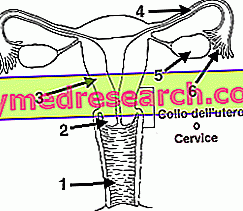Watch the video
X Watch the video on youtubeWhat are almonds
Botanical notes and description of almonds
Almond is the name of the edible seed produced by the almond tree (botanical name Prunus dulcis ), a plant about 10 m high belonging to the Rosaceae family.

"Almond" is also the term used to indicate all the seeds that have the same characteristics (of peach, apricot, cherry, etc.).
Bitter almond
Bitter almond is the seed produced by Prunus amygdalus, a botanical species used mainly for ornamental purposes.
The bitter taste of these seeds is attributable to the presence of amygdalin, a cyanogenic glycoside (ie capable of releasing cyanide) which, if ingested in large quantities, is very harmful to health. The almond is more bitter and its venomous power is greater.
The toxicity of amygdalin can be canceled by cooking; therefore, at dosages that would still be harmless, it is traditional to add bitter almond extract in the preparation of some sweet specialties such as macaroons.
Nutritional Properties
Food classification
Almonds are foods that belong to the whole of oil seeds, commonly called "dried fruit". In the classification of the 7 fundamental food groups, oleaginous fruits are not classified in a clear and distinct manner. This because:
- Although they are seeds, they are poor in starch and do not belong to the whole of cereals and legumes (III and IV fundamental group of foods)
- Although they are fruits, they are poor in water, in fructose, in vitamin A, C and do not fall within the set of sweet fleshy fruits (VI and VII fundamental group of foods).
On the contrary, they contain a lot of fat and little water.
Nutritional characteristics
Almonds are fruits rich in triglycerides, very high in calories even though they still have excellent digestibility.
The lipid profile of almonds is characterized by a very strong presence of unsaturated fatty acids; monounsaturated lipids (oleic acid, the same as extra virgin olive oil, present in quantities of 32% of total lipids) abound above all, but the content of essential omega-6 polyunsaturated fatty acids (linoleic acid, to the extent of 13% on total lipids).
Almonds contain only 5% saturated fat and are cholesterol free.
The protein intake, if contextualized in the context of plant-based foods, is quite high and contributes to making the almond a first-rate food in the vegan diet. The glucose content is just as relevant and affects calories as much as protein.
Some vitamins also abound in the seeds of the almond tree:
- Water soluble, such as riboflavin or vit B2, niacin or vit PP and thiamine or B1
- Fat-soluble, especially alpha-tocopherol or vit E.
There are also mineral salts, some of which are normally lacking in the western diet; the levels of manganese, magnesium, calcium, copper, phosphorus and zinc are noteworthy.
Almonds (especially with peel) contain excellent amounts of dietary fiber, a nutritional factor very useful for maintaining the balance of intestinal flora and the proper functioning of the colon.
The beneficial role of almond peel is emerging recently. This fibrous coating, besides being rich in prebiotic fibers, contains admirable levels of antioxidant polyphenols. In particular the concentrations of flavonols, flavan-3-oils, hydroxybenzoic acids and flavanones stand out, otherwise contained above all in the fruit and vegetable products.
Almonds do not contain lactose or gluten, which is why they lend themselves to the diet due to their intolerances.
They can be subject to allergic reaction in hypersensitive subjects.
Because of their high caloric intake (almost 600 kcal / 100 g), dried almonds must be consumed with a certain moderation (no more than 10-15 seeds per day, which corresponds to 20-30 g), especially by those who are still far from reaching its proper weight.
They have no contraindications for people suffering from metabolic pathologies; on the contrary, if used intelligently, they help optimize the parameters of lipemia.
 | |||
| almonds | |||
| Nutritional values per 100 g | |||
| Power | 576 kcal | ||
| Total carbohydrates | 21.69 g | ||
| Starch | 0.74 g | ||
| Simple sugars | 3.89 g | ||
| Grassi | 49.42 g | ||
| Saturated | 3.73 g | ||
| Monounsaturated | 30.89 g | ||
| polyunsaturated | 12.01 g | ||
| Protein | 21.22 g | ||
| fibers | 12.2 g | ||
| water | 4.7 g | ||
| Vitamins | |||
| Vitamin A equivalent | 1.0 μg | 0% | |
| Thiamine or B1 | 0.211 mg | 18% | |
| Riboflavin or B2 | 1.014 mg | 85% | |
| Niacin or PP or B3 | 3.385 mg | 23% | |
| Pantothenic acid or B5 | 0.469 mg | 9% | |
| Pyridoxine or B6 | 0.143 mg | 11% | |
| Folic acid | 50.0 μg | 13% | |
| Choline | 52.1 mg | 11% | |
| Ascorbic acid or C | 0.0 mg | 0% | |
| Vitamin D | 0.0 μg | 175% | |
| Alpha-tocopherol or E | 26.2 mg | 2% | |
| Vit. K | 0.0 μg | 0% | |
| Minerals | |||
| Football | 264.0 mg | 26% | |
| Iron | 3.72 mg | 29% | |
| Magnesium | 268.0 mg | 75% | |
| Manganese | 2.285 mg | 109% | |
| Phosphorus | 484.0 mg | 69% | |
| Potassium | 705.0 mg | 15% | |
| Sodium | 1.0 mg | 0% | |
| Zinc | 3.08 mg | 32% | |
Risks for the health of almonds
The health risks related to almond consumption mainly concern fungal contamination (from Aspergillus flavus and Aspergillus parasiticus ) and the consequent release of aflatoxins. These are highly hepatotoxic agents that, in the worst cases, induce the formation of liver cancer.
In 2007, the European Union introduced legislation to ensure that all almond imports are subjected to the specific test for aflatoxin. If they do not meet the minimum requirements, the entire lot can be reworked or destroyed.
Purposes
Almonds are used on their own, as a food, or as an ingredient / pastry ornament (nougat, cakes, puddings, almond cakes and confetti).
Almond food
Available especially in dried form (fresh ones are subject to seasonality), almonds are sold naturally, sweet or savory, with or without peel.
Note : the salt could be used to cover the rancid taste of a poor quality seed.
Almonds in shell, if stored in a cool and dry place, can easily be stored for a few months. On the contrary, when deprived of their woody shell they perish quickly and should be hermetically stored in a cool, dry place.
From the almonds you can get some derivatives, among which the most famous are almond milk, almond oil, almond flour and almond syrup.
Almond milk
Almond milk is a thick, fragrant and healthy drink. It is produced by diluting the mixture obtained by blending the almonds with water.
Before use, almond milk is agitated because, due to its high lipid content, it tends to separate into two distinct phases. It also quickly becomes sour and must therefore be kept in the fridge.
Almond oil
Almond oil is obtained by pressing sweet almond seeds and is mainly used in the cosmetic field, where it is used for its soothing and emollient properties (it protects the skin, softens and firms it, preventing stretch marks). If taken as a food, it has moderate laxative properties and brings significant amounts of good fats and fat-soluble vitamins.
Almond flour
Almond flour is what remains from the extraction of almond oil. In confectionery it is mainly used to package biscuits, cakes and sweets. It is used very much:
- In raw food cooking, since it is edible even raw
- In the vegan one, as an alternative source of protein
- In that of the celiac, regarding the absence of gluten.
Note : with almond flour it is possible to make a dough.
Almond syrup
Almond syrup consists of an emulsion of almonds (today only sweet, in the past they were also used bitter ones), barley or cane syrup and synthetic aroma.
Recipes with Almonds
Video Almond Chicken Recipe
Almond chicken
X Problems with video playback? Reload from YouTube Go to Video Page Go to Video Recipes Section Watch the video on youtubeSee all Almond Recipes »



